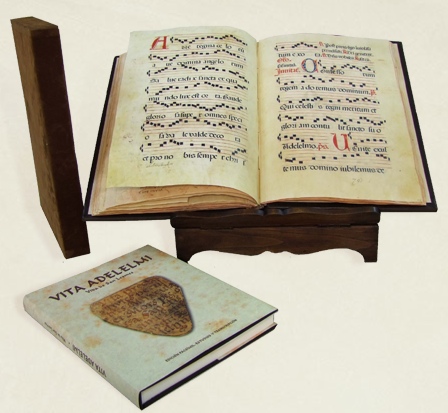| This complex and colorful parchment manuscript in use for four centuries in Burgos—a paleographical and repertorial treasure trove for students of medieval Spain—gives a detailed account of the life of San Lesmes, together with all the chants that celebrate this saint. It’s an interesting combination of two completely different parts united in the 16th century. Part A (fols. 11-53) is a remnant of a 14th-c. plenary breviary following the Roman rite written in German gothic script. The life and miracles of San Lesmes follow on fols. 54-77. The musical notation of this section is primarily Aquitanian notated on a single reference line, however chants (in a different notational style) also appear, obviously added in later centuries, a typical pattern of mss that have been in use for a long periods of time. This section includes among other curiosities the first known use of the Spanish version of the eucharistic anthem
Pange lingua” (fol. 30v). Part B of the ms (fols. 78-93) provides the necessary chants and liturgy to celebrate the mass and office of St. Lesmes including matins and laudes. Executed in the middle of the 16th c. the script is gothic and the chants are provided in quadratic notation on a 5-line staff. This part of the ms includes many gloses and annotations in the margins and unlike the first section has not sustained any losses. The entire manuscript has been bound in parchment with a quasi heart-shape etikette pasted on the cover with the words “Vita preclara virtutes perillustres miracula et mors preciossa sanctissimi patris nostri adelelmi”. The ms was in the continuous possession of the Monastery of San Juan until 1835, when it was transferred to the Cistercian nuns of the Monastery of San Felices de Burgos where it is now kept.
 |
|
| 


St. Lesmes was born in Loudun, France, located between Poitiers and Angers. Although he had the privilege of being born in a good family and had an excellent education he didn't become well known as a scientist or man of letters but as as man who made extraordinary things out of the ordinary and dedicated his life to those in need. His virtues and character became known to Queen Constanza, the wife of Alfonso VI of Spain, who begged him to come to the court, believing that his example could change some of the bad behaviors there. This is how St. Lesmes arrived in Burgos ca. 1081-1083 and never abandoned this town. After working for some time as the spiritual adviser to the queen he was given the Chapel and Monastery of St. Juan to establish a Benedictine community. After a year the monastery became a priorate under the Burgundian Abbey Casa Dei which was in charge of the education of the monks and very importantly to place them alongside the “Camino de Santiago”. Although the king appointed St. Lesmes as the Abbot of the monastery he rejected the position in order to follow his mission, to live a complete ascetic life dedicated to help the poor and the pilgrims. St. Lesmes died in 1097
The role of the Camino de Santiago: King Alfonso VI had a program of social change and development not directly connected with agrarian production but with activities that intensified commercial and cultural interchange. He saw the need to activate the ways of communication and measures to guarantee the physical security of merchants and pilgrims. One of the very important measures that the king took was to eliminate the “portazgo” (toll) collected in the port of Valcarce in Bierzo, Leon, one that specially affected the pilgrims headed for Santiago. The king was related to Pope Calixtus who was a brother of his son in law, the Count of Galicia; this Pope and the people of Cluny had originated and promoted the pilgrimage to Santiago. With the impulse given by the king new centers were created to fulfill the demands generated by the trade and a new infrastructure made possible the development of villages and towns along the Camino of Santiago. Since the beginning of the 11th century the Camino became gradually more and more active and important, a development achieved spontaneously within the frame of the demographic and economic growth of Western Europe and with the increasing mobility of the population and the infiltration of the economic and cultural influences of the Northern Pyrenees. Naturally the legend of the apostle Santiago’s preachings, his death in Palestine and the journey that carried his body for his exhumation in the peninsula was another force for the pilgrimage and Santiago de Compostela became then and now a destination place for people from all over the world.
|
|
|





